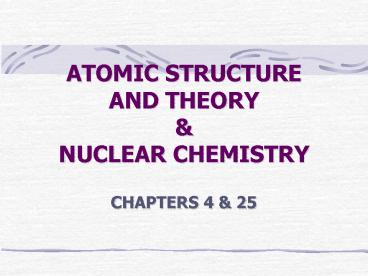ATOMIC STRUCTURE AND THEORY PowerPoint PPT Presentation
1 / 26
Title: ATOMIC STRUCTURE AND THEORY
1
ATOMIC STRUCTURE AND THEORYNUCLEAR CHEMISTRY
- CHAPTERS 4 25
2
Early Models of the Atom
- Democritus (450 BC) Matter is composed of tiny
indivisible particles. - Daltons Atomic Theory (1803) Based on four
statements. - Each element is composed of atoms.
- Atoms of the same element are alike and differ
from any other element. - Atoms can not be created nor destroyed by
chemical reactions. - Atoms combine in simple whole number ratios.
3
- Atom The smallest particle of an element that
retains the chemical identity of that element. - Approximately 114 elements. The alphabet of
chemistry. - The chemists goal is to understand the atoms
that make up the world.
4
Discovering Atomic Structure
- Magnetism The theory for the discovery of the
electron and proton. - Electrostatics Opposite charges attract and
likes repel. - Benjamin Franklin An object could have one of
two charges (positive or negative). - Michael Faraday (1839) Drew the connection
between the electrical current and the structure
of the atom.
5
Equipment to Isolate Sub-Atomic Particles
- Eugene Goldstein Designed the cathode ray tube
and the canal ray tube. - Vacuum inside, current flows between cathode and
the anode (blue), source of electrons or x-rays.
6
Discovery of the ElectronJ.J. Thompson
- Defines the charge of the electron.
- Designs the mass spectrometer.
- Begins to define the mass of the electron.
- Places bar magnets around the tube and creates a
magnetic field in which the beam of blue light
bends toward the positive pole of the magnet.
7
Defining the ElectronRobert Milikan
- Defines a more accurate mass of the electron.
- Oil Drop Experiment
- Timed the rate at which the charged oil drop
would rise and fall depending upon the strength
of the electromagnetic field vs. the strength of
gravity.
8
Discovery of the Proton
- Eugene Goldstein Defined the charge of the
proton. - J.J. Thompson Defined the mass of the proton to
be 1837 times the mass of the electron.
9
The Nuclear AtomRutherford
- Gold Foil Experiment
- Concluded a nucleus existed.
- Contained the positive charge as well as the
majority of the mass.
10
Atomic Structure
- Atoms are composed of protons, neutrons, and
electrons. - Create chart on the board of sub-atomic particles
for comparison.
11
Atomic Number and Mass
- Atomic number Z of protons.
- Atomic mass M of protons and neutrons.
- An individual atom is electrically neutral.
- Protons Electrons.
- p Z, Charge p - e, and n M Z.
12
IONS
- Created when an atom gains or loses one or more
electrons. - It acquires a net electrical charge.
- Charge of ion the number of protons the
number of electrons.
13
Isotopes
- Daltons postulate that all atoms of a given
element are identical is not exactly true. - An isotope is an atom that has the same number of
protons but a different number of neutrons.
14
Periodic TableDevelopment
- Why?
- Mendeleev
- Based on increasing atomic mass.
- Predictions.
- Moseley
- Based on increasing atomic number.
- Why did Mendeleevs work?
- Periodic Law When elements are arranged in
order of increasing atomic number, their physical
and chemical properties show a periodic pattern.
15
- Metals Properties include luster or shine, good
conductors of heat/electricity, malleable, and
ductile. - Nonmetals Large variation in properties.
- Metalloids or Semimetals The in between.
16
- Family Names
- Representative (1A 8A)
- Transition (1B 8B)
- Inner Transition
- Alkali Metals
- Alkaline Earth Metals
- Boron family
- Carbon family
- Nitrogen family
- Oxygen family
- Halogens
- Noble gases
17
Nuclear ChemistryThe Changing Nucleus
- Strong Nuclear Force between extremely close
subatomic particles. - Atomic s 1 thru 20 protons neutrons.
- Past 20 Need more neutrons than protons to be
stable. - Past 83 All are radioactive.
- Too many or too few neutrons radioactivity.
18
RadioactivityAlpha, Beta, and Gamma
- Distinguished by charge, mass, and penetrating
power. - Radioactive decay when an atom emits one of
these kinds of radiation. - Decay nucleus decays to form a new nucleus
releasing radiation in the process. - Nuclear reactions change the composition of the
atoms nucleus.
19
Types of Radiation
20
Nuclear Equations
- Keep track of the reactions components.
- The sum of the mass numbers and atomic numbers
are the same before and after. - Sample problems.
21
Effects of Radiation
- Harmful to living things
- Effects depend on the amount and type.
- Effects on living tissue
- Ionizing radiation disrupts living cells.
- Somatic damage direct.
- Genetic damage reproduction.
22
Uses of Nuclear Chemistry
- Radioactive dating.
- Smoke detectors.
- Imaging.
- Radiotracers.
- Cancer therapy.
- Food preservation.
- Energy.
23
Measuring Radiation
- Equipment
- Dosimeter.
- Geiger counter.
24
Nuclear EnergyNuclear Fission
- A large nucleus is split into two smaller nuclei
of approximately the same mass. - The missing mass energy.
- Nuclear chain reactions.
- Nuclear reactors.
- Three Mile Island (loss of coolant).
- Chernobyl (failure of the moderator).
- Waste disposal (fuel rods and burial).
25
Nuclear EnergyNuclear Fusion
- Two small nuclei join to form a large nucleus.
- Difficult to produce and control.
- Electron cloud repulsion.
- Nucleus repulsion.
- Benefits
- Uses hydrogen abundant.
- No radioactive waste.
- Problem
- High temps required.
26
Half-life
- The half-life of a radioactive isotope is the
time it takes for one half of a sample of that
isotope to decay. - Uranium-238 4.5 billion years (alpha decay).
- Carbon-14 5,730 years (beta decay).
- Sample problems.

